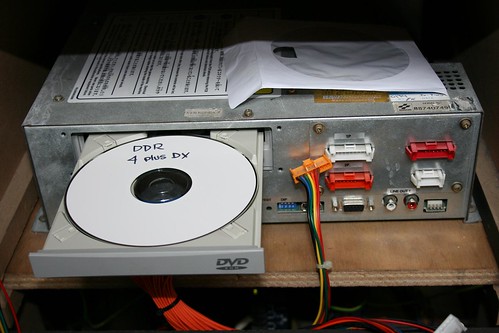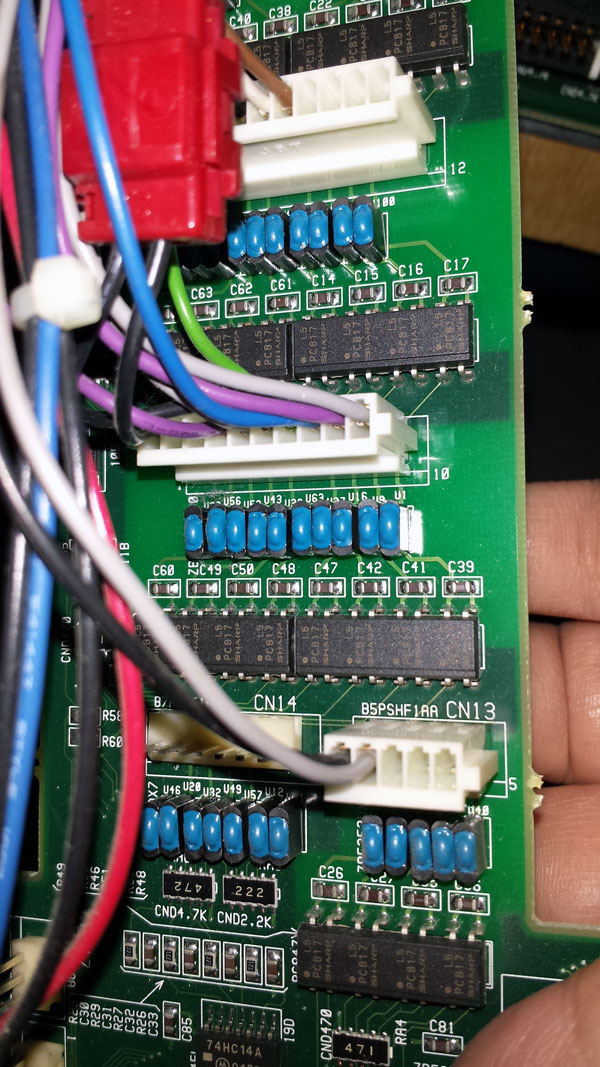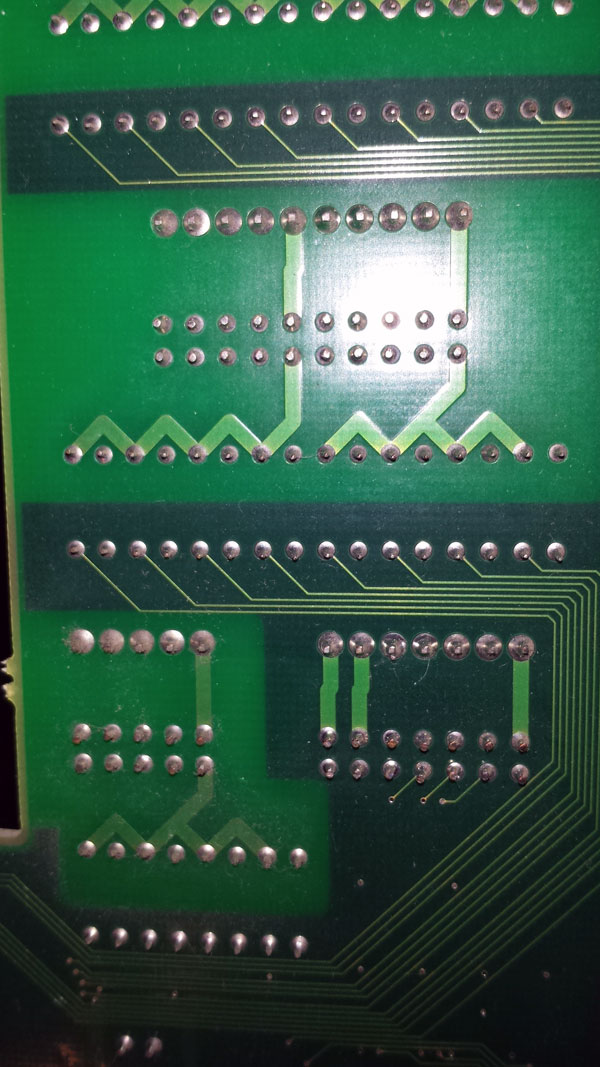Project Goals:
A few years ago I bought one of my all time favorite arcade games, Dance Dance Revolution. It's a traditional 2-player "SD" Japanese cab (Commonly referred to as an "Extreme cab"). I believe it had originally shipped as a 5th Mix in Japan. but was converted to a bootleg copy of Extreme.
The cab needed a lot of work but I got it for cheap money so I didn't mind fixing it up... $600 and a month of work later I had a machine that looked and played like new. But I wanted to load new songs on the game, play the entire DDR song catalog and more. The Ultimate goal is to have a DDR machine that looks and plays like the original arcade version but is capable of offering thousands of songs to choose from and allows me to easily add or remove songs as I like.
From what I understand there's no way to do this with the original System 573 hardware (maybe there is some solution on SOWS but I'm not privy to it) Many people like to run Open In the Groove (the software that runs the dance machines of the same name) which is based on StepMania and is an open source knock-off of Dance Dance Revolution.
I found someone who calls themselves Beware who had made a complete "Simulation" of DDR Extreme using the StepMania v3.9 Source Code. It's a nearly perfect recreation of DDR Extreme. The benefit of course is that it also supports the ability to load up any StepMania or Open ITG songs.
You can get Beware's Extreme here: http://zenius-i-vanisher.com/v5.2/thread?threadid=5076
Zenius-i-vanisher (or ZIV) also hosts a pretty comprehensive database of song files that you can use: http://zenius-i-vanisher.com/v5.2/simfiles.php?category=simfiles
For User Files I highly recommend checking out the "SpeirMix" collections, they're very well done and similar quality to the originally Konami tracks. Most user created track files only included very high difficulty versions and are missing the light/standard level variants, so be wary of that if you're new to this

^astute DDR players will notice that is the Extreme song selection interface but that's (and a few others) are not tracks available on Extreme
This gets me most of the way there, the game on-screen looks like the real Arcade DDR, it plays like the real Arcade DDR, and I can manage my own custom song lists. but there's one problem and that's the arcade cabinet lights.
A Background on the problem with Light Output and SM:
Beware's Extreme, being based on SM 3.9 has one significant problem: SM 3.9 has a lot of problems with light output.
SM 3.9 only support light output via the parallel ports, more-over the address for the parallel ports is hard-coded such that only PCs with a built in parallel port will work (since expansion boards use a different address), then there's the problem that there are so many lights that you need 2 parallel ports to support them all. It's hard enough finding a motherboard with 1 parallel port these days, never mind a mobo with two of them. And if that wasn't enough a final kick in the nuts is that the light output code is disabled in the windows compile to avoid a licensing issue that came up with the parallel port library used. (the Linux driver has all the same issues but at least it's enabled).
There is an alternate compile of SM3.9 called SM3.9+ Redux that re-enables light output and fixes a few other minor issues. SM4.x and 5.x also re-enable light output. But Beware's extreme is based on the original official SM 3.9 code. Open In the Groove (which I believe is based on SM4.x) added several new light drivers, the parallel drivers are still crappy but they're enabled, it also added support for the ITGIO board used in the ITG arcade machines as well as support for the Ultimac PAC-Drive...
The System 573 uses a JAMMA harness, the audio skips the JAMMA harness and is instead output via un-amplified Stereo RCA jacks where it goes to a separate amplifier box that provides cross-over and amplification functions. There are also 4 additional connectors for lights, these connectors also provide some kind of serial data connection to the dance pads that is really only used in the service menu to troubleshoot sensor problems.

^not mine but this is what the DDR System 573 looks like, the JAMMA connector is under the CD drive.
the 4 connectors at the top right are for, Player 1 Pad Lights and Serial Data, Player 2 Pad Lights and Serial Data, Marquee Spots Lights and Control Panel Lights, and Bass Lights respectively.
To hook a PC up you can use a JAMMA harness and a stereo patch cable, the serial data connection to the pads isn't supported by any PC program that I know of (if you know different please tell me) so that gets ignored... but then that leaves the lights.
Parallel ports can be used but then you need to hook them up to mosfets or transistor in order to drive the lights in the cab. Even if you use a PAC-Drive on Open ITG you'll blow out the PAC Drive trying to drive the cabinet lights so you need something in-between.
The ITG IO board could be used but they're expensive, hard to find, and only supported by ITG builds of the software.
The best solution is actually a board called a MiniMaid, this was a custom built board by someone on SOWS that provided a plug-and-play solution to hooking a PC up in place of a System 573. It provided the JAMMA edge connector as well as the 4 light ports with all the supporting hardware necessary. It worked with openITG and they provided patched SM .exe files that included the necessary drivers for light output with the board... information on this board can be found here: http://zenius-i-vanisher.com/v5.2/thread?threadid=6298
There are a few problems with this, the MiniMaid was $320 before they discontinued production which was high enough but now that you can't get them new anymore, people who have them are unwilling to sell or are able to fetch prices in the $600 range to people who want them. For my personal build another problem is that it can never work with Beware's extreme because it doesn't have the patch to support the board and I've been unsuccessful in finding anyone who is willing or able to provide the uncompilable patch code so Beware's extreme can be patched (if anyone can make this happen, please get a hold of me).
My Solution to Light Output:
I like the MiniMaid solution because it's a single piece of hardware that everything just connects to and works, but the cost and availability and lack of integration with Beware's Extreme put it out of the running. The next best choice is the J-PAC A lot of the hardcore Rhythm game players hate on anything that's not MiniMaid but I've read a fair share of lag tests on the J-PAC and I have a hard time believing that anything else out there can top it, especially other systems that use the same communication protocols and similar chipsets since the only thing contributing to the in imperceivable lag in the current generation of J-PACs is the PC itself, not the J-PAC.
For light output with a J-PAC the most obvious option is the PAC-Drive made by Ultimarc, it's as ubiquitous as the J-PAC, it's well supported and in current production and it only costs $30, not to mention it's already supported by ITG so I'd only have to build drivers that work in StepMania.
Once the Software is done I'll have to build a transistor board that adapts the PAC drive to the light harness in the cab.
A few years ago I bought one of my all time favorite arcade games, Dance Dance Revolution. It's a traditional 2-player "SD" Japanese cab (Commonly referred to as an "Extreme cab"). I believe it had originally shipped as a 5th Mix in Japan. but was converted to a bootleg copy of Extreme.
The cab needed a lot of work but I got it for cheap money so I didn't mind fixing it up... $600 and a month of work later I had a machine that looked and played like new. But I wanted to load new songs on the game, play the entire DDR song catalog and more. The Ultimate goal is to have a DDR machine that looks and plays like the original arcade version but is capable of offering thousands of songs to choose from and allows me to easily add or remove songs as I like.
From what I understand there's no way to do this with the original System 573 hardware (maybe there is some solution on SOWS but I'm not privy to it) Many people like to run Open In the Groove (the software that runs the dance machines of the same name) which is based on StepMania and is an open source knock-off of Dance Dance Revolution.
I found someone who calls themselves Beware who had made a complete "Simulation" of DDR Extreme using the StepMania v3.9 Source Code. It's a nearly perfect recreation of DDR Extreme. The benefit of course is that it also supports the ability to load up any StepMania or Open ITG songs.
You can get Beware's Extreme here: http://zenius-i-vanisher.com/v5.2/thread?threadid=5076
Zenius-i-vanisher (or ZIV) also hosts a pretty comprehensive database of song files that you can use: http://zenius-i-vanisher.com/v5.2/simfiles.php?category=simfiles
For User Files I highly recommend checking out the "SpeirMix" collections, they're very well done and similar quality to the originally Konami tracks. Most user created track files only included very high difficulty versions and are missing the light/standard level variants, so be wary of that if you're new to this


^astute DDR players will notice that is the Extreme song selection interface but that's (and a few others) are not tracks available on Extreme

This gets me most of the way there, the game on-screen looks like the real Arcade DDR, it plays like the real Arcade DDR, and I can manage my own custom song lists. but there's one problem and that's the arcade cabinet lights.
A Background on the problem with Light Output and SM:
Beware's Extreme, being based on SM 3.9 has one significant problem: SM 3.9 has a lot of problems with light output.
SM 3.9 only support light output via the parallel ports, more-over the address for the parallel ports is hard-coded such that only PCs with a built in parallel port will work (since expansion boards use a different address), then there's the problem that there are so many lights that you need 2 parallel ports to support them all. It's hard enough finding a motherboard with 1 parallel port these days, never mind a mobo with two of them. And if that wasn't enough a final kick in the nuts is that the light output code is disabled in the windows compile to avoid a licensing issue that came up with the parallel port library used. (the Linux driver has all the same issues but at least it's enabled).
There is an alternate compile of SM3.9 called SM3.9+ Redux that re-enables light output and fixes a few other minor issues. SM4.x and 5.x also re-enable light output. But Beware's extreme is based on the original official SM 3.9 code. Open In the Groove (which I believe is based on SM4.x) added several new light drivers, the parallel drivers are still crappy but they're enabled, it also added support for the ITGIO board used in the ITG arcade machines as well as support for the Ultimac PAC-Drive...
The System 573 uses a JAMMA harness, the audio skips the JAMMA harness and is instead output via un-amplified Stereo RCA jacks where it goes to a separate amplifier box that provides cross-over and amplification functions. There are also 4 additional connectors for lights, these connectors also provide some kind of serial data connection to the dance pads that is really only used in the service menu to troubleshoot sensor problems.

^not mine but this is what the DDR System 573 looks like, the JAMMA connector is under the CD drive.
the 4 connectors at the top right are for, Player 1 Pad Lights and Serial Data, Player 2 Pad Lights and Serial Data, Marquee Spots Lights and Control Panel Lights, and Bass Lights respectively.
To hook a PC up you can use a JAMMA harness and a stereo patch cable, the serial data connection to the pads isn't supported by any PC program that I know of (if you know different please tell me) so that gets ignored... but then that leaves the lights.
Parallel ports can be used but then you need to hook them up to mosfets or transistor in order to drive the lights in the cab. Even if you use a PAC-Drive on Open ITG you'll blow out the PAC Drive trying to drive the cabinet lights so you need something in-between.
The ITG IO board could be used but they're expensive, hard to find, and only supported by ITG builds of the software.
The best solution is actually a board called a MiniMaid, this was a custom built board by someone on SOWS that provided a plug-and-play solution to hooking a PC up in place of a System 573. It provided the JAMMA edge connector as well as the 4 light ports with all the supporting hardware necessary. It worked with openITG and they provided patched SM .exe files that included the necessary drivers for light output with the board... information on this board can be found here: http://zenius-i-vanisher.com/v5.2/thread?threadid=6298
There are a few problems with this, the MiniMaid was $320 before they discontinued production which was high enough but now that you can't get them new anymore, people who have them are unwilling to sell or are able to fetch prices in the $600 range to people who want them. For my personal build another problem is that it can never work with Beware's extreme because it doesn't have the patch to support the board and I've been unsuccessful in finding anyone who is willing or able to provide the uncompilable patch code so Beware's extreme can be patched (if anyone can make this happen, please get a hold of me).
My Solution to Light Output:
I like the MiniMaid solution because it's a single piece of hardware that everything just connects to and works, but the cost and availability and lack of integration with Beware's Extreme put it out of the running. The next best choice is the J-PAC A lot of the hardcore Rhythm game players hate on anything that's not MiniMaid but I've read a fair share of lag tests on the J-PAC and I have a hard time believing that anything else out there can top it, especially other systems that use the same communication protocols and similar chipsets since the only thing contributing to the in imperceivable lag in the current generation of J-PACs is the PC itself, not the J-PAC.
For light output with a J-PAC the most obvious option is the PAC-Drive made by Ultimarc, it's as ubiquitous as the J-PAC, it's well supported and in current production and it only costs $30, not to mention it's already supported by ITG so I'd only have to build drivers that work in StepMania.
Once the Software is done I'll have to build a transistor board that adapts the PAC drive to the light harness in the cab.
Last edited:

 Even after all that there were some weird behaviors introduced because I was trying to force it to compile on a slightly newer Visual Studio version. I ended up just giving my patch to Beware and he was kind enough to recompile his R3 version with my PacDrive patch (this also includes re-enabling of Parallel Port light output).
Even after all that there were some weird behaviors introduced because I was trying to force it to compile on a slightly newer Visual Studio version. I ended up just giving my patch to Beware and he was kind enough to recompile his R3 version with my PacDrive patch (this also includes re-enabling of Parallel Port light output).

